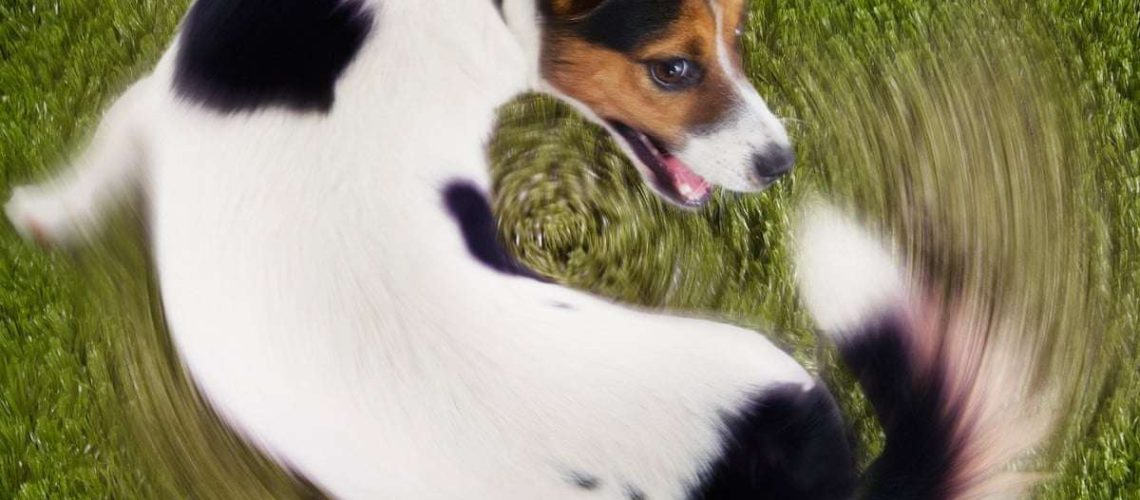Key Takeaways:
- Dogs may chase their tails out of boredom or as a form of entertainment.
- Chasing their tails can also be a sign of anxiety or stress in dogs.
- Some dogs may chase their tails due to medical reasons, such as fleas or allergies.
- Tail chasing behavior can be reduced through proper exercise and mental stimulation.
- If tail chasing becomes excessive or obsessive, it is important to consult a veterinarian for further evaluation and guidance.
Have you ever wondered why dogs chase their tails? It's a quirky behavior that many of us find amusing, but there's more to it than meets the eye. Understanding why dogs engage in this playful activity can provide valuable insights into their instincts and well-being. By exploring this topic, we can uncover the hidden motivations behind tail chasing and gain a deeper appreciation for our furry friends. So, let's embark on a fascinating journey into the world of canine behavior and discover the secrets behind this adorable phenomenon. Get ready to be captivated by the intriguing reasons why dogs chase their tails!
Why do dogs chase their tails?
When dogs chase their tails, it can be quite amusing to watch. But have you ever wondered why they do it? Well, there are a few reasons that might explain this behavior. One reason is that dogs may chase their tails simply because they are bored or looking for something fun to do. Just like humans, dogs need mental and physical stimulation to keep them happy and healthy. If they don't have enough activities to keep them occupied, they may resort to tail-chasing as a way to entertain themselves.
Another reason dogs chase their tails could be due to a predatory instinct. Dogs are descendants of wolves, and wolves often chase their prey in the wild. So when a dog sees its tail moving, it may trigger their natural hunting instincts, causing them to give chase. Additionally, some experts believe that tail-chasing could be a form of self-soothing behavior in dogs. Just like how humans may bite their nails or twirl their hair when feeling anxious or stressed, dogs may chase their tails as a way to calm themselves down.
Different Types of Tail-Chasing
Tail-chasing can vary from dog to dog. Some dogs may only give an occasional chase while others might become obsessed with it and do it frequently throughout the day. There are even cases where dogs will continuously spin in circles while chasing their tails, which can be concerning.
Normal Tail-Chasing: This is when a dog occasionally chases its tail but doesn't seem overly fixated on it. It's usually harmless and doesn't require any intervention.
Compulsive Tail-Chasing: In some cases, tail-chasing can become compulsive behavior for certain dogs. They may become obsessed with chasing their tails and find it difficult to stop, even when they are tired or in pain. This can be a sign of an underlying medical or behavioral issue and should be addressed by a veterinarian or a professional dog trainer.
Common Reasons for Tail-Chasing
- Boredom: Dogs may chase their tails out of boredom, especially if they don't have enough mental and physical stimulation.
- Predatory Instincts: The sight of a moving tail may trigger a dog's natural hunting instincts, leading them to give chase.
- Anxiety or Stress: Some dogs may chase their tails as a way to self-soothe when feeling anxious or stressed.
- Medical Issues: Certain medical conditions like fleas, allergies, anal gland problems, or injuries can cause dogs to chase their tails due to discomfort or irritation.
Understanding the reasons behind tail-chasing can help dog owners determine if it is normal behavior or if there is an underlying issue that needs attention. If you notice excessive tail-chasing or any signs of distress in your dog, it's always best to consult with a veterinarian for proper guidance.
How do dogs feel when they chase their tails?
The excitement of the chase
When dogs chase their tails, they often do so out of pure excitement. It's like a game for them, and they enjoy the thrill of trying to catch something that seems elusive. Tail-chasing can be a way for dogs to release pent-up energy or boredom. They may feel a rush of adrenaline as they spin in circles, trying to catch their own tail. It's important to note that not all dogs find tail-chasing enjoyable; some may become frustrated or anxious during the process.
A sense of accomplishment
For some dogs, catching their tail can bring a sense of accomplishment. When they finally manage to grab hold of it, they might feel victorious and proud. This behavior is more common in puppies who are still exploring their bodies and learning about cause and effect. However, it's essential for dog owners to ensure that tail-chasing doesn't become an obsessive behavior that interferes with the dog's overall well-being.
Are all dogs interested in chasing their tails?
Not all dogs are interested in chasing their tails. While tail-chasing is relatively common among many breeds, some dogs simply have no interest in this behavior. Factors such as breed traits, individual personality, and environmental stimulation can influence whether a dog finds tail-chasing appealing or not.
Breed tendencies
Certain dog breeds are more prone to chasing their tails than others. For example, high-energy breeds like Border Collies and Australian Shepherds may be more inclined to engage in this behavior due to their natural herding instincts and need for mental stimulation. On the other hand, calmer breeds like Bulldogs or Basset Hounds may show little interest in chasing their tails.
Environmental factors
The environment in which a dog lives can also impact their interest in tail-chasing. Dogs who lack mental and physical stimulation may resort to tail-chasing as a way to entertain themselves. Providing plenty of exercise, playtime, and interactive toys can help prevent excessive tail-chasing behavior.
Which other animals exhibit behavior similar to tail-chasing in dogs?
While tail-chasing is commonly associated with dogs, it is not exclusive to them. Several other animals exhibit similar behaviors that involve chasing or biting their own tails.
Cats
Cats are known for their playful nature, and some cats may engage in tail-chasing behavior. Like dogs, they may find it entertaining or stimulating. However, unlike dogs, tail-chasing is generally less common in cats and often occurs during kittenhood.
Horses
Horses are powerful creatures but can also display playful behaviors. Some horses may chase or bite at their own tails as a form of self-amusement or as a response to irritation caused by flies or other insects.
Other animals
Tail-chasing-like behaviors have also been observed in certain primates, such as monkeys and apes. Additionally, some small rodents like mice or rats may exhibit repetitive circular movements that resemble tail-chasing.
It's important to note that while these animals may engage in similar behaviors, the underlying motivations and reasons behind them can vary significantly from those of dogs.
Is tail-chasing normal for dogs or a sign of something else?
Tail-chasing behavior in dogs can be considered normal up to a certain extent. It's not uncommon for puppies and young dogs to chase their tails occasionally as part of their development and exploration process. However, excessive or obsessive tail-chasing could indicate an underlying issue that requires attention.
Possible medical causes
In some cases, dogs may chase their tails due to medical conditions such as allergies, fleas, or anal gland problems. These issues can cause discomfort or itchiness in the tail area, leading the dog to chase or bite at their tail as a way to alleviate the irritation. If a dog's tail-chasing becomes excessive or accompanied by other concerning symptoms, it's crucial to consult a veterinarian to rule out any underlying health problems.
Behavioral and psychological factors
Tail-chasing can also be triggered by behavioral or psychological factors. Dogs that are bored, anxious, stressed, or lacking mental stimulation may resort to tail-chasing as a coping mechanism. It's essential for dog owners to provide a stimulating environment, engage in regular exercise and playtime, and address any underlying behavioral issues through positive reinforcement training techniques.
Do certain dog breeds chase their tails more than others?
Yes, certain dog breeds are more prone to chasing their tails than others. While tail-chasing behavior can occur in any breed, some breeds have a higher tendency towards this behavior due to various factors.
Herding breeds
Herding breeds such as Border Collies, Australian Shepherds, and Shetland Sheepdogs have strong instincts related to chasing and controlling movement. These instincts can manifest in behaviors like tail-chasing when they don't have an outlet for their energy and mental stimulation.
High-energy breeds
Breeds known for their high energy levels like Jack Russell Terriers or Dalmatians may also be more inclined to chase their tails. These dogs require plenty of physical exercise and mental stimulation to prevent boredom-related behaviors such as excessive tail-chasing.
Anxiety-prone breeds
Certain breeds with predispositions towards anxiety or compulsive behaviors may also exhibit increased tail-chasing tendencies. Breeds like German Shepherds, Cocker Spaniels, or Bull Terriers may be more prone to developing obsessive behaviors, including tail-chasing.
How can dog owners prevent excessive tail-chasing in their pets?
Preventing excessive tail-chasing in dogs involves providing a stimulating environment and addressing any underlying issues that may contribute to the behavior.
Physical exercise and mental stimulation
Regular physical exercise is crucial for dogs to release energy and reduce boredom. Engaging in activities like daily walks, playtime, or interactive toys can help redirect their focus away from tail-chasing. Mental stimulation through puzzle toys or training sessions can also keep their minds occupied.
Positive reinforcement training
Using positive reinforcement techniques, such as rewarding desired behaviors and redirecting attention away from tail-chasing, can be effective. Teaching commands like "leave it" or "sit" can help distract the dog when they start chasing their tail and redirect their attention to more appropriate activities.
Seek professional help if needed
If a dog's tail-chasing behavior persists despite efforts to prevent it or if it becomes excessive and interferes with their well-being, consulting a professional dog trainer or animal behaviorist is recommended. They can provide tailored guidance and strategies to address the underlying causes of the behavior and develop a personalized plan for prevention.
In conclusion, dogs may chase their tails for various reasons. It could be due to boredom, seeking attention, or even as a form of play. Understanding these behaviors can help us provide them with the right care and stimulation to keep them happy and healthy.
Is it normal for a dog to chase its tail?
It is a common occurrence to witness dogs chasing their own tails, often in repetitive circular motions. This behavior is often seen as a form of enjoyment for the dog, as they are exploring their physical abilities and curiosity about their bodies. This behavior can be observed in dogs as a means of play and self-discovery.
Do dogs know they are chasing their tails?
According to her explanation, cats and dogs are conscious that their tails are a part of their bodies. However, it may take puppies and kittens some time to fully understand this. Although they may not think of their tails in the same way humans do, they have the ability to control their tail movements and can feel when their tails are touched, resulting in a response.
Do happy dogs chase their tails?
At times, your dog may experience intense happiness and become extremely excited about the day. This can lead her to spin around or chase her tail for a brief period. You may notice that when she is particularly enthusiastic about something, such as a new toy or the opportunity to go for a walk, she will consistently display this behavior whenever that exciting event occurs.
What breed of dog chases its tail?
According to Williams, a study suggests that certain breeds such as Bull Terriers, German Shepherds, and Staffordshire Bull Terriers may have a higher tendency to chase their tails. However, even dogs without tails may engage in this behavior. Williams explains that in some cases, dogs may spin rapidly without showing any interest in their tails.
Why is my dog obsessed with chasing her tail?
In an interview for the American Kennel Club, veterinarian Dr. Steve Weinberg explains that obsessive chasing behavior in dogs may be caused by a brain abnormality similar to seizures. Other potential reasons for this behavior include pain from a docked tail, infection, or even cancer.
How do I stop compulsive tail chasing?
If dogs are not receiving sufficient physical activity, there is a straightforward solution to stop them from chasing their tails. By providing dogs with more aerobic exercise such as playing fetch or going for a walk, they may stop chasing their tails. After all, most dogs prefer chasing a ball over their own tails.

















